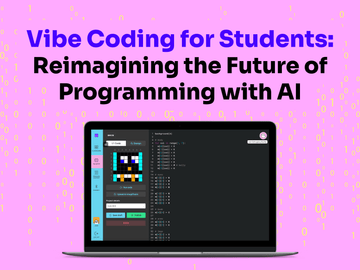
In the world of programming, you'll encounter two main styles: block-based and text-based coding. Picture it like this: block-based coding is the DJ who serves you pre-made beats that you can mix and match, while text-based coding is more like a maestro composing a symphony from scratch. Block-based coding uses colorful puzzle-like blocks to build a program from pre-selected pieces. On the other hand, text-based coding lets you dive into the actual process of writing lines of code with no limit to creativity.
While block-based coding may be a good fit for getting younger kids acquainted with the concept of coding, a study published by Northwestern University indicated that 50% of block-based programming students in high school expressed difficulty transitioning to text-based programming. Therefore, exposing students to a text-based coding curriculum earlier in their schooling can help your students learn how to code independently and help prepare them for higher-level coding courses in high school and college. In this article, we’ll highlight five benefits of choosing a text-based curriculum to prepare middle school students for advanced computer science courses and beyond!
Simplicity and Readability

While text-based coding languages can seem challenging at first, choosing a coding curriculum that teaches a coding language like Python or JavaScript with a simpler syntax compared to other languages like C and C++ can make it easier for middle school kids, while also helping increase their comfort level in understanding and writing actual code. If the code is more readable, it allows them to focus on problem-solving and logical thinking instead of worrying about complex syntax and terminology.
For instance, the commands for printing a string, `print("Hello, world!")`, or iterating through a list, `for item in my_list:`, shows how Python syntax can be more user-friendly and accessible for young coders.
Quick Feedback and Debugging

Text-based languages typically provide immediate feedback, allowing students to see the results of their code instantly and learn how to correct mistakes. Unlike block-based approaches, text-based languages offer explicit error messages, which are crucial for identifying and resolving issues effectively and enhancing learners' coding proficiency. This instant feedback helps students understand and correct errors or bugs in the actual code more efficiently, encouraging a hands-on and iterative approach to learning.
The picture above demonstrates a typical syntax error message in Python, highlighting the location and type of error a student has made. Learning how to correct one’s mistakes is a challenging but rewarding experience that can ultimately boost a student's coding confidence and perseverance - especially when they encounter higher-level computer science courses later in life.
Versatility and Real-World Applications
Text-based coding languages are versatile and widely used in various domains, including web development, data analysis, and automation. Therefore, choosing a coding curriculum that teaches text-based coding from the start can equip middle school kids with skills that can be applied to real-world scenarios, fostering their creativity and problem-solving abilities. In today’s world, Python skills, for example, can be applied to almost any industry, be it digital art or medical science! For the curious ones, we have a blog post that explores 100 real-life examples of Python usage.
Engaging and Interactive Learning

Text-based coding curriculum that also leverages interactive environments and visual tools can make the learning process more engaging and enjoyable for middle school students. When students can create interactive programs, build games, explore data visualizations, or create something tangible with their code, the learning process can become even more fun and rewarding.
In fact, there are several programs that teach Python coding through interactive games or creating art. With imagi, students can express themselves creatively by coding pixel art designs and bringing them to life on the wearable imagiCharm device. If you want to learn more, check out these 5 great tools to teach Python coding at school.
Foundation for Advanced Programming

Text-based languages serve as a strong foundation for learning more complex programming concepts and languages in the future. By starting with a text-based language or transitioning to a text-based coding curriculum in middle school, kids can develop a solid understanding of programming fundamentals, which can be easily transferred to other languages and technologies as they progress in their coding journey.
Final words
Text-based coding offers an array of benefits for middle school students, including simplicity, extensive feedback, versatility, engaging learning experiences, and a strong foundation for advanced programming. By leveraging a text-based coding curriculum to teach coding to your middle school students, you can help them unlock a world of creative programming and gain valuable coding skills that will benefit them in the future.Curious what a text-based coding curriculum looks like? If you’re an educator, you can try the first few lessons of imagi’s text-based coding curriculum for free by signing up for our coding platform imagi Edu.




